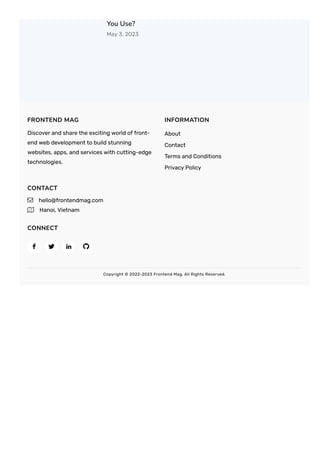Decoding Svelte and SvelteKit: Unveiling the Key Distinctions
- 1. Home Insights Svelte vs SvelteKit: Understanding Key Di몭erences and Similarities Svelte vs SvelteKit: Understanding Key Differences and Similarities AUTHOR Tien Nguyen DATE May 12, 2023 CATEGORY Insights In today’s digital landscape, you have many options for building modern web This website uses cookies to ensure you get the best experience on our website. Learn more x
- 2. In today’s digital landscape, you have many options for building modern web applications. Two popular frameworks in this space are Svelte and SvelteKit. In this article, we’ll explore Svelte and SvelteKit in detail, discovering what they have in common and how they di몭er. Whether you’re an experienced developer or new to coding, understanding these frameworks is crucial for making informed choices in your projects. Throughout this post, I’ll guide you on a comprehensive tour of Svelte vs SvelteKit, highlighting their strengths, architectural styles, and tools. By the end, you’ll have a clear understanding of what makes these frameworks unique and how they can be used to create exceptional web applications. So, let’s dive in! Understanding Svelte Table of Contents 1. Understanding Svelte 2. Exploring SvelteKit 3. Svelte vs SvelteKit 4. Language and Syntax 5. Component-based Architecture 6. Routing and Navigation 7. SSR 8. State Management 9. Performance and Bundle Size 10. Learning Curve and Documentation 11. Use Cases and Real-world Examples 12. Pros and Cons 13. Conclusion 14. FAQs Got it
- 3. Before we delve into the comparisons, let’s start by gaining a solid understanding of Svelte itself. Svelte is a modern JavaScript framework that has been gaining popularity for its innovative approach to building web applications. Unlike traditional frameworks that run in the browser, Svelte takes a di몭erent approach. At its core, Svelte is a compiler. It compiles your declarative code into highly e몭cient JavaScript code that runs in the browser. This means that instead of shipping a bulky framework library to the client, Svelte compiles your components into optimized code during the build process. One of the key advantages of Svelte is its simplicity and lightweight nature. With Svelte, you don’t need to deal with complex virtual DOM or heavy runtime libraries. Instead, you focus on writing expressive and reactive components using Svelte’s intuitive syntax. Svelte introduces the concept of reactive statements, allowing you to declaratively de몭ne how your components respond to changes in data. This reactive nature of Svelte enables a smooth and e몭cient rendering process, ensuring that only the necessary parts of your application are updated when data changes. Additionally, Svelte embraces a component-based architecture. You can break down your application into reusable and self-contained components, each with its own logic and styling. These components can be easily composed together to build complex user interfaces, promoting code reusability and maintainability. With Svelte, you also have the 몭exibility to choose your preferred state management approach. Whether you opt for the built-in reactivity system or prefer to use external state management libraries like Redux or MobX, Svelte o몭ers seamless integration. Exploring SvelteKit
- 4. In this section, we’ll shift our focus to SvelteKit, a framework built on top of Svelte. SvelteKit takes the robust foundation of Svelte and enhances it with additional features, making it an excellent choice for building scalable and dynamic web applications. SvelteKit is designed to address the challenges of building larger, multi-page applications. It introduces server-side rendering (SSR), allowing you to pre-render your application on the server and deliver optimized HTML to the client. This approach improves initial load times and ensures search engine optimization (SEO) bene몭ts. One of the signi몭cant advantages of SvelteKit is its integrated routing system. It provides a straightforward way to de몭ne and handle routes within your application. Whether you need simple static routes or dynamic routes that fetch data from external APIs, SvelteKit has you covered. It simpli몭es the process of creating navigational 몭ows and handling user interactions. SvelteKit also embraces a modular architecture, allowing you to organize your application into separate routes and layouts. Each route can have its own set of components, styles, and logic, promoting code separation and maintainability. This modular structure makes it easier to collaborate with other developers and scale your application as it grows. Another notable feature of SvelteKit is its built-in support for serverless functions. With serverless functions, you can o몭oad backend logic to serverless platforms like AWS Lambda or Azure Functions. This enables you to build dynamic and interactive features without the need for a traditional backend server. SvelteKit bene몭ts from the same simplicity and reactivity that Svelte o몭ers. You can still leverage Svelte’s intuitive syntax, reactive statements, and component-based architecture while enjoying the additional capabilities provided by SvelteKit. Svelte vs SvelteKit The following table summarizes the key features of Svelte and SvelteKit:
- 5. Feature Svelte SvelteKit Language and Syntax Simple and intuitive syntax Builds upon Svelte syntax Component-based Architecture Yes Yes Routing and Navigation Requires external library Built-in routing system Server-side Rendering (SSR) No Built-in SSR capabilities State Management Reactive variables Reactive variables + Stores Performance and Bundle Size Small bundle size Optimal performance and bundling Learning Curve and Documentation Easy to learn Extensive documentation and resources Use Cases Single-page applications Multi-page applications, larger projects In the following sections, we’ll dive into each aspect in more detail. Language and Syntax When it comes to language and syntax, both Svelte and SvelteKit share a common foundation since SvelteKit is built on top of Svelte. However, there are some di몭erences and additional features introduced by SvelteKit. Svelte Svelte uses a straightforward and expressive syntax that focuses on simplicity and readability. It employs a component-based approach where you de몭ne your UI elements as reusable Svelte components. The syntax resembles HTML and JavaScript, making it easy for developers familiar with these languages to get started. In Svelte, you write your component templates using HTML-like markup with the addition of special directives and reactive statements. These directives allow you to handle events, conditionally render content, iterate over arrays, and bind data to HTML elements. JavaScript code is seamlessly integrated within the component, allowing you to de몭ne component-speci몭c logic and manipulate data. You can write JavaScript code inside
- 6. component-speci몭c logic and manipulate data. You can write JavaScript code inside script tags using the familiar JavaScript syntax. Here’s a simple code example to demonstrate how Svelte works: In this example, we have a Svelte component called . Inside the tag, we declare a variable and set its initial value to . This variable will be reactive, meaning any changes to it will automatically update the corresponding parts of the user interface. SvelteKit SvelteKit builds upon the Svelte syntax and extends it with additional features to facilitate building multi-page applications. It introduces a routing system that enables you to de몭ne and handle routes within your application. In SvelteKit, you de몭ne your routes using a dedicated routing syntax, where you specify the route path and associate it with a speci몭c component. This allows you to create separate pages for di몭erent URLs and manage the navigation 몭ow of your application. SvelteKit also provides a layout system, which allows you to de몭ne common layouts that are shared across multiple pages. This helps in maintaining consistent styling and structure throughout your application. Furthermore, SvelteKit introduces SSR capabilities. With SSR, you can de몭ne server- side endpoints that handle data fetching and pre-render your application on the server. This provides the bene몭t of improved initial load times and SEO. 1. <! App.svelte > 2. <script> 3. let name = 'Tien Nguyen'; 4. </script> 5. 6. <main> 7. <h1>Hello, {name}!</h1> 8. <p>Welcome to the exciting world of Svelte.</p> 9. 10. <label> 11. Enter your name: 12. <input type="text" bind:value={name}> 13. </label> 14. </main> App.svelte <script> name 'Tien Nguyen'
- 7. Here is a basic example of a SvelteKit app that has three routes: , , and : / /about /posts/[id] index.svelte 1. <! src/routes/index.svelte > 2. <script> 3. // this is the home page 4. </script> 5. 6. <h1>Welcome to SvelteKit</h1> 7. <nav> 8. <a href="/about">About</a> 9. <a href="/posts/1">First post</a> 10. <a href="/posts/2">Second post</a> 11. </nav> about.svelte 1. <! src/routes/about.svelte > 2. <script> 3. // this is the about page 4. </script> 5. 6. <h1>About SvelteKit</h1> 7. <p>SvelteKit is a framework for building fullstack web applications using Svelte components and serverside rendering. </p> 8. <a href="/">Go back home</a> [id].svelte 1. <! src/routes/posts/[id].svelte > 2. <script context="module"> 3. // this function runs on the server and returns props for the component 4. export async function load({ params, fetch }) { 5. // get the post id from the params object 6. const { id } = params; 7. 8. // fetch the post from an API 9. const res = await fetch(`https://jsonplaceholder.typicode.com/posts/${id}`); 10. const post = await res.json(); 11. 12. // return the post as props 13. return { 14. props: { 15. post 16. } 17. };
- 8. Component-based Architecture Both Svelte and SvelteKit embrace a component-based architecture, which promotes code reusability, modularity, and maintainability. However, there are some di몭erences in how components are created and used in each framework. Svelte In Svelte, components are at the heart of building user interfaces. You de몭ne components as reusable building blocks that encapsulate their own markup, styles, and logic. Each component consists of three main parts: the HTML-like template, the JavaScript code, and the optional CSS styles. Components in Svelte can be easily reused throughout your application. You can import and use components within other components, allowing for composition and building complex user interfaces. Svelte’s reactivity system ensures that changes in data 몭ow seamlessly through the component hierarchy, triggering UI updates as needed. SvelteKit In SvelteKit, the component-based architecture remains similar to Svelte, with some additional features to facilitate building multi-page applications. Components play a crucial role in de몭ning the UI for each page. Each page in SvelteKit is associated with a speci몭c component that acts as its main template. This component represents the entire content and logic for that particular page. You can de몭ne components within a page component to encapsulate reusable parts of the page UI or functionality. 18. } 19. </script> 20. 21. <script> 22. // receive the props from the load function 23. export let post; 24. </script> 25. 26. <! this is a dynamic page that displays a post based on the id > 27. <h1>{post.title}</h1> 28. <p>{post.body}</p> 29. <a href="/">Go back home</a>
- 9. SvelteKit introduces layouts, which are higher-order components that de몭ne the common structure, styles, and behaviors shared across multiple pages. Layouts allow you to create consistent headers, footers, sidebars, or navigation menus that are applied to multiple pages. The component-based nature of SvelteKit makes it easy to create and manage complex application structures. You can break down your application into modular components, organize them in a logical hierarchy, and reuse them across multiple pages and layouts. Routing and Navigation Routing and navigation are essential aspects of building web applications, allowing users to navigate between di몭erent pages or views. Both Svelte and SvelteKit o몭er solutions for handling routing and navigation, albeit with some variations. Svelte In Svelte, handling routing and navigation requires the integration of external routing libraries or manual implementation. There are popular routing libraries available, such as Svelte Routify or Svelte SPA Router, that provide routing capabilities for Svelte applications. These routing libraries allow you to de몭ne routes and associate them with speci몭c components. You can specify route parameters, handle dynamic URLs, and handle navigation events such as clicking on links or programmatically triggering navigation. With a routing library in Svelte, you can achieve client-side routing, where navigation occurs within the browser without a full page reload. This provides a smooth user experience as the content updates dynamically without the need for a complete page refresh. SvelteKit SvelteKit simpli몭es the process of routing and navigation by providing an integrated routing system. It allows you to de몭ne routes directly within your SvelteKit application without the need for external routing libraries. In SvelteKit, you de몭ne routes in a dedicated directory, specifying the URL routes
- 10. path and associating it with a corresponding page component. This approach provides a clear and centralized way to de몭ne the navigational structure of your application. SvelteKit supports both client-side navigation and SSR. When a user navigates between pages, the appropriate page component is rendered and displayed without a full page reload. This ensures a seamless and responsive user experience. Additionally, SvelteKit supports features like route parameters, query parameters, and nested routes. You can de몭ne dynamic segments in your routes, allowing you to handle URLs with variable values. This 몭exibility enables you to create dynamic and interactive web applications. With SvelteKit’s integrated routing system, you can easily manage the navigation 몭ow of your application, handle di몭erent routes, and create dynamic pages without relying on external routing libraries. SSR Let’s examine how Svelte and SvelteKit handle SSR. Svelte By default, Svelte focuses on client-side rendering, where the application is rendered and executed on the client’s browser. If you want to support SSR in your Svelte app, use SvelteKit. SvelteKit SvelteKit introduces built-in SSR capabilities, making it easier to adopt and leverage SSR in your applications. With SvelteKit, SSR is seamlessly integrated into the framework’s routing system. When a request is made to a SvelteKit application, the server pre-renders the corresponding page on the server and sends back the pre-rendered HTML to the client. This initial HTML payload ensures fast and meaningful content for users, enhancing the overall user experience. SSR in SvelteKit is particularly bene몭cial for content-heavy applications or scenarios where SEO is a priority. By delivering pre-rendered HTML to search engine crawlers, you can improve the discoverability and ranking of your application in search engine results.
- 11. results. In addition to SSR, SvelteKit also supports client-side hydration. Once the initial HTML is loaded, SvelteKit takes over on the client side and rehydrates the application, making it interactive and reactive. This combination of SSR and client-side hydration o몭ers the best of both worlds. By providing integrated server-side rendering capabilities, SvelteKit simpli몭es the process of adopting SSR and o몭ers a powerful solution for building performant and SEO-friendly web applications. State Management State management is a crucial aspect of web application development, as it allows you to manage and share data between components e몭ciently. Let’s examine how Svelte and SvelteKit handle state management. Svelte Svelte provides a built-in reactive system that simpli몭es state management within components. With Svelte’s reactivity, you can declaratively de몭ne how your components react to changes in data. In Svelte, you can declare variables and reactive statements within your component’s JavaScript code. These variables can hold the state of your application, and when they change, Svelte automatically updates the a몭ected parts of the UI. Svelte’s reactive nature eliminates the need for complex state management libraries in many cases. You can handle state within individual components using simple reactive assignments and conditionals. However, if your application requires more advanced state management or you prefer to use external state management libraries, Svelte allows seamless integration with popular libraries like Redux or MobX. This 몭exibility empowers you to choose the state management approach that best suits your application’s needs. SvelteKit SvelteKit inherits the reactive state management capabilities of Svelte and extends them to handle state management at the application level.
- 12. In SvelteKit, you can de몭ne shared state using the and stores. The store holds data that persists across multiple pages and client-side navigations, while the store holds data speci몭c to the current page. These stores allow you to share and synchronize data between di몭erent components and pages in your SvelteKit application. By leveraging the stores, you can ensure that the shared state remains consistent and reactive across the entire application. With the combination of reactive state management and the application-level stores in SvelteKit, you have powerful tools to handle state e몭ectively and share data between components and pages. Performance and Bundle Size Performance and bundle size are critical considerations when developing web applications. Let’s explore how Svelte and SvelteKit fare in terms of performance and bundle size. Svelte Svelte is known for its excellent performance due to its compile-time approach. During the build process, Svelte compiles the components into highly optimized JavaScript code that is speci몭cally tailored to the component’s functionality. This approach results in leaner and more e몭cient code compared to traditional runtime frameworks. Svelte’s compile-time approach also eliminates the need for a virtual DOM, which reduces the overhead associated with virtual DOM di몭ng and reconciliation. This leads to faster initial rendering and updates, resulting in a smoother user experience. Moreover, Svelte’s reactive nature allows it to update only the a몭ected parts of the UI when the underlying data changes. This 몭ne-grained reactivity minimizes unnecessary updates and further enhances the performance of Svelte applications. In terms of bundle size, Svelte produces compact bundles due to its e몭cient compilation process. Svelte optimizes the output by removing unused code, tree- shaking dependencies, and generating minimal runtime overhead. This results in smaller bundle sizes, allowing for faster downloads and improved page load times. SvelteKit $session $page $session $page
- 13. SvelteKit SvelteKit inherits the performance bene몭ts of Svelte while also introducing additional optimizations speci몭c to web applications. SvelteKit leverages SSR to pre-render pages on the server, providing fast initial content loading and improved perceived performance. By sending pre-rendered HTML to the client, users can view meaningful content without waiting for JavaScript to load and execute. After the initial load, SvelteKit takes over on the client side and rehydrates the application, making it interactive and reactive. This combination of server-side rendering and client-side hydration provides a smooth and responsive user experience. When it comes to bundle size, SvelteKit optimizes the generated bundles by automatically splitting code and loading components and dependencies on demand. This lazy-loading approach reduces the initial bundle size and improves the overall performance of the application. In short, both Svelte and SvelteKit prioritize performance and aim to generate e몭cient and optimized applications. Svelte’s compile-time approach and 몭ne-grained reactivity contribute to its excellent performance, while SvelteKit combines SSR, client-side hydration, and lazy-loading to enhance the overall performance and user experience. Learning Curve and Documentation The learning curve and availability of comprehensive documentation are important factors to consider when adopting a new framework. Let’s examine the learning curve associated with Svelte and SvelteKit and the resources available to support your learning journey. Svelte Svelte o몭ers a relatively gentle learning curve, especially for developers familiar with web development concepts like JavaScript, HTML and CSS. Its syntax is intuitive and easy to understand, making it accessible for beginners and experienced developers alike. The o몭cial Svelte documentation serves as an excellent resource for learning the framework. It provides detailed explanations, code examples, and tutorials to guide you through the core concepts and features of Svelte. The documentation covers topics
- 14. through the core concepts and features of Svelte. The documentation covers topics ranging from basic usage to advanced techniques, making it a comprehensive learning companion. In addition to the o몭cial documentation, the Svelte community actively creates tutorials, blog posts, video courses, and other learning materials. These community resources can further assist you in gaining a deeper understanding of Svelte and exploring best practices for building applications. SvelteKit SvelteKit builds upon the concepts of Svelte and introduces additional features, so the learning curve may be slightly steeper compared to Svelte. However, if you are already familiar with Svelte, transitioning to SvelteKit should be relatively smooth. The SvelteKit documentation provides a dedicated section that covers the unique features and usage of the framework. It guides you through the process of setting up a SvelteKit project, understanding the routing system, handling SSR, and more. The documentation is well-structured and o몭ers practical examples to help you grasp the concepts e몭ectively. Additionally, the Svelte community and SvelteKit Discord channels serve as valuable platforms for seeking assistance, sharing experiences, and engaging with fellow developers. These communities foster a collaborative learning environment where you can connect with others and gain support as you explore SvelteKit. Use Cases and Real-world Examples Understanding the practical use cases and seeing real-world examples of applications built with Svelte and SvelteKit can help you evaluate their suitability for your projects. Let’s explore the use cases and highlight some notable examples. Svelte Svelte’s simplicity, performance, and reactivity make it a great choice for a wide range of applications. Some common use cases for Svelte include: 1. Single-page Applications (SPAs): Svelte’s lightweight nature and e몭cient rendering make it well-suited for building SPAs that require fast initial loading, seamless navigation, and smooth user interactions.
- 15. 2. UI Components and Libraries: Svelte’s component-based architecture and reusability make it an excellent choice for developing UI components and libraries that can be easily integrated into di몭erent projects. 3. Data Visualization: Svelte’s reactive capabilities make it ideal for building interactive data visualizations and dashboards where data updates can trigger real- time updates in the UI. 4. Prototyping and Proof of Concepts: Svelte’s simplicity and rapid development cycle make it a great tool for quickly prototyping ideas and creating proof of concepts. Some notable examples of applications built with Svelte include: GoDaddy: A company that specializes in providing website hosting and domain registration services. The New York Times: An in몭uential daily newspaper based in New York City, widely read by people around the world. 1Password: A password manager that o몭ers a convenient and secure way for users to store and manage their passwords, software licenses, and other sensitive information in a virtual vault, protected by a master password. SvelteKit SvelteKit’s additional features expand its range of use cases. Here are some scenarios where SvelteKit shines: 1. Full-stack Applications: SvelteKit’s built-in SSR and routing capabilities make it suitable for building full-stack applications, where both the server and client components are seamlessly integrated. 2. Content-rich Websites and Blogs: SvelteKit’s SSR enables fast and SEO-friendly content delivery, making it an excellent choice for content-rich websites and blogs. 3. E-commerce Platforms: SvelteKit’s performance optimizations and SSR can enhance the user experience on e-commerce platforms, providing fast initial page loads and search engine visibility. 4. Collaborative Applications: SvelteKit’s real-time updates and reactive nature make it suitable for building collaborative applications that require real-time data synchronization and seamless user interactions. Some real-world examples of applications built with SvelteKit include:
- 16. Some real-world examples of applications built with SvelteKit include: Appwrite – an open-source backend as a service that provides developers with a set of APIs to help them build applications faster. OneSkool – an online learning platform. Nordic SvindKit – a company that uses SvelteKit in their tech stack. These examples highlight the versatility of Svelte and SvelteKit in various domains and their ability to power both small-scale projects and complex, production-ready applications. Pros and Cons Considering the pros and cons of Svelte and SvelteKit can help you weigh the advantages and limitations of each framework. Let’s examine the key strengths and weaknesses of both frameworks. Svelte Pros: E몭ciency: Svelte’s compile-time approach and absence of a virtual DOM result in highly optimized and performant applications. Reactivity: Svelte’s reactivity system simpli몭es state management and updates only the necessary parts of the UI, leading to faster rendering and responsiveness. Simplicity: Svelte’s intuitive syntax and straightforward concepts make it easy to learn and use, particularly for developers familiar with HTML, CSS, and JavaScript. Smaller Bundle Sizes: Svelte’s compilation process generates lean and compact bundles, resulting in faster downloads and improved page load times. Active Community: Svelte has a growing and supportive community that contributes tutorials, libraries, and resources to aid developers in their journey. Cons: Limited Ecosystem: While the Svelte ecosystem is expanding, it may not o몭er the same breadth of tools, libraries, and resources as more established frameworks. Learning Curve for Reactive Paradigm: Developers transitioning from imperative or virtual DOM-based frameworks may need to adapt to Svelte’s reactive paradigm
- 17. or virtual DOM-based frameworks may need to adapt to Svelte’s reactive paradigm and the absence of explicit lifecycle methods. SvelteKit: Pros: SSR: SvelteKit provides built-in SSR capabilities, resulting in faster initial content loading, improved SEO, and enhanced perceived performance. Client-side Hydration: SvelteKit seamlessly transitions from SSR to client-side interactivity, o몭ering a smooth and responsive user experience. Routing and Layouts: SvelteKit’s integrated routing system and layouts simplify the management of routes and shared structures across pages. Ecosystem Compatibility: SvelteKit bene몭ts from the existing Svelte ecosystem while adding speci몭c features for building web applications. Cons: Limited Maturity: As a relatively new framework, SvelteKit may have fewer resources and community plugins compared to more established frameworks. Learning Curve: SvelteKit’s additional features and concepts may introduce a slightly steeper learning curve, especially for developers new to Svelte. Conclusion In summary, we have explored the key di몭erences and similarities between Svelte and SvelteKit, two powerful web development frameworks. If you’re looking for a simple and e몭cient way to build single-page applications, Svelte might be the right choice. However, if you’re working on larger projects that require routing, SSR, and a more comprehensive ecosystem, SvelteKit provides the necessary tools and features. Ultimately, both frameworks o몭er tremendous value and empower developers to create exceptional web applications. Whether you prefer the simplicity of Svelte or the extended capabilities of SvelteKit, you can’t go wrong with either choice. You might want to checkout the following comparisons of Svelte vs other frameworks:
- 18. Svelte vs SolidJS Svelte vs NextJS If you have any questions or need further assistance, feel free to refer to the FAQs section or leave a comment below. Happy coding! FAQs Here are some frequently asked questions about Svelte and SvelteKit: 1. Can I use Svelte components in SvelteKit? Yes, Svelte components can be seamlessly used in SvelteKit projects. SvelteKit builds upon the concepts of Svelte, so you can leverage your existing Svelte components or create new ones to build your application. 2. Can I migrate my existing Svelte project to SvelteKit? Yes, migrating an existing Svelte project to SvelteKit is possible and relatively straightforward. SvelteKit provides a migration guide in its documentation to help you transition your project smoothly. 3. How does server-side rendering (SSR) work in SvelteKit? SvelteKit incorporates SSR by pre-rendering your application on the server before sending it to the client. This enables faster initial content loading and improves SEO by providing fully rendered HTML to web crawlers. 4. What is the performance di몭erence between Svelte and SvelteKit? Both Svelte and SvelteKit emphasize performance, but SvelteKit’s SSR and client-side hydration provide additional bene몭ts. SSR helps improve initial content loading, while client-side hydration ensures interactivity and responsiveness after the initial page load. However, the exact performance gains depend on the speci몭c application and use case. 5. Are there any notable companies or projects using Svelte or SvelteKit? Yes, Svelte and SvelteKit have gained popularity and are used by various companies and projects. Some notable examples include GoDaddy, The New York Times, and 1Password. These applications showcase the versatility and capabilities of both frameworks. 6. Which framework is better for beginners: Svelte or SvelteKit? For beginners, Svelte is often considered a good starting point due to its simplicity and intuitive syntax. It provides a solid foundation for understanding reactive programming and
- 19. building web applications. Once familiar with Svelte, transitioning to SvelteKit becomes more accessible, leveraging the knowledge gained from working with Svelte. PREVIOUS ARTICLE 10 Best Books for HTML and CSS [2023]: Beginners to Advanced You may also like WebSocket vs WebRTC: Choosing the Right Protocol for Real-Time Communication Flutter vs React Native: The Ultimate Comparison (2023) Next JS vs Express: An In-Depth Comparison for Developers LEAVE A REPLY Comment: Name:* Email:* Website: Save my name, email, and website in this browser for the next time I comment. POST COMMENT
- 20. POST COMMENT Recent posts 10 Best Books for HTML and CSS [2023]: Beginners to Advanced May 11, 2023 Is CSS Hard to Learn? Discovering the Truth Behind Learning CSS May 10, 2023 WebSocket vs WebRTC: Choosing the Right Protocol for Real- Time Communication May 9, 2023 Is JavaScript Hard to Learn? Demystifying the Learning Curve and Tips for Success May 7, 2023 Shallow Copy vs Deep Copy in JavaScript: Which One Should You Use?
- 21. You Use? May 3, 2023 FRONTEND MAG Discover and share the exciting world of front- end web development to build stunning websites, apps, and services with cutting-edge technologies. INFORMATION About Contact Terms and Conditions Privacy Policy CONTACT hello@frontendmag.com Hanoi, Vietnam CONNECT Copyright © 2022-2023 Frontend Mag. All Rights Reserved.


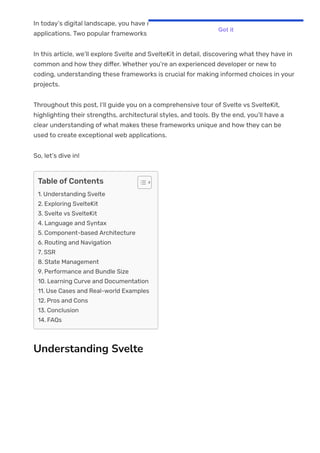

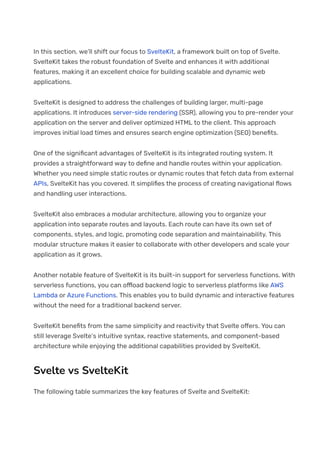
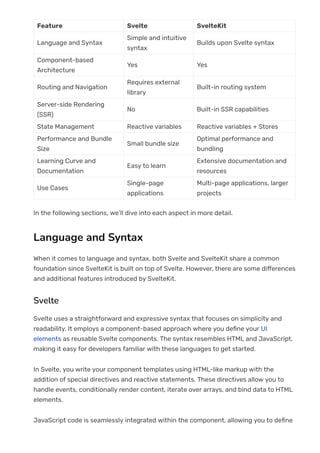

![Here is a basic example of a SvelteKit app that has three routes: , ,
and :
/ /about
/posts/[id]
index.svelte
1. <! src/routes/index.svelte >
2. <script>
3. // this is the home page
4. </script>
5.
6. <h1>Welcome to SvelteKit</h1>
7. <nav>
8. <a href="/about">About</a>
9. <a href="/posts/1">First post</a>
10. <a href="/posts/2">Second post</a>
11. </nav>
about.svelte
1. <! src/routes/about.svelte >
2. <script>
3. // this is the about page
4. </script>
5.
6. <h1>About SvelteKit</h1>
7. <p>SvelteKit is a framework for building fullstack web
applications using Svelte components and serverside rendering.
</p>
8. <a href="/">Go back home</a>
[id].svelte
1. <! src/routes/posts/[id].svelte >
2. <script context="module">
3. // this function runs on the server and returns props for the
component
4. export async function load({ params, fetch }) {
5. // get the post id from the params object
6. const { id } = params;
7.
8. // fetch the post from an API
9. const res = await
fetch(`https://jsonplaceholder.typicode.com/posts/${id}`);
10. const post = await res.json();
11.
12. // return the post as props
13. return {
14. props: {
15. post
16. }
17. };](https://image.slidesharecdn.com/www-frontendmag-com-insights-svelte-vs-sveltekit-230513054557-17ab3a13/85/Decoding-Svelte-and-SvelteKit-Unveiling-the-Key-Distinctions-7-320.jpg)

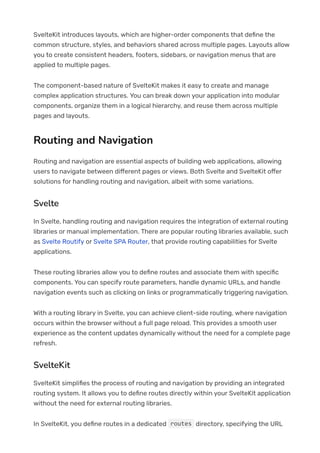

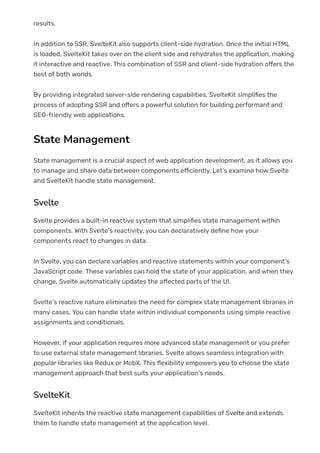
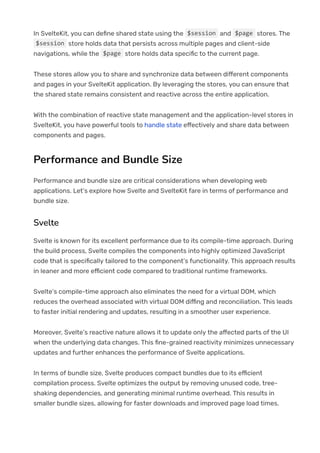


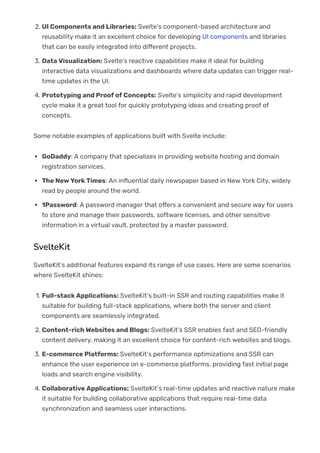



![building web applications. Once familiar with Svelte, transitioning to SvelteKit becomes
more accessible, leveraging the knowledge gained from working with Svelte.
PREVIOUS ARTICLE
10 Best Books for HTML and CSS [2023]:
Beginners to Advanced
You may also like
WebSocket vs WebRTC:
Choosing the Right Protocol for
Real-Time Communication
Flutter vs React Native: The
Ultimate Comparison (2023)
Next JS vs Express: An In-Depth
Comparison for Developers
LEAVE A REPLY
Comment:
Name:*
Email:*
Website:
Save my name, email, and website in this browser for the next time I comment.
POST COMMENT](https://image.slidesharecdn.com/www-frontendmag-com-insights-svelte-vs-sveltekit-230513054557-17ab3a13/85/Decoding-Svelte-and-SvelteKit-Unveiling-the-Key-Distinctions-19-320.jpg)
![POST COMMENT
Recent posts
10 Best Books for HTML and CSS [2023]: Beginners to
Advanced
May 11, 2023
Is CSS Hard to Learn? Discovering the Truth Behind Learning
CSS
May 10, 2023
WebSocket vs WebRTC: Choosing the Right Protocol for Real-
Time Communication
May 9, 2023
Is JavaScript Hard to Learn? Demystifying the Learning Curve
and Tips for Success
May 7, 2023
Shallow Copy vs Deep Copy in JavaScript: Which One Should
You Use?](https://image.slidesharecdn.com/www-frontendmag-com-insights-svelte-vs-sveltekit-230513054557-17ab3a13/85/Decoding-Svelte-and-SvelteKit-Unveiling-the-Key-Distinctions-20-320.jpg)
